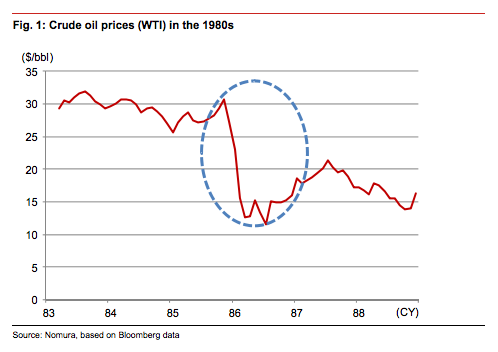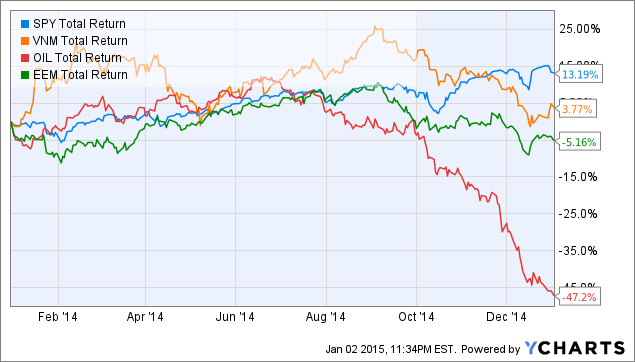Where To Focus In Emerging Markets With The Oil Price Collapse
Post on: 27 Май, 2015 No Comment

With oil prices down over 39% since the highs of June this year, many investors have been caught off-guard. 1 It is important for investors to consider how their portfolios are being impacted by lower energy prices, especially if the weakness persists. We focus our attention on the emerging markets (EM). as they both have large exposures in energy-producing companies and are the largest energy consumers in the world. 2 The oil price dynamics are causing large divergences in returns across countries—creating many winners and losers.
One way to draw this distinction is to study the landscape for both the net oil importers and the exporters. The basic premise is that net oil importers tend to be beneficiaries of lower prices because they are able to meet their energy needs at a lower cost. From a regional perspective, both emerging Europe (especially Russia) and Latin America tend to be oil exporters, while Asia is one of the largest oil importers, second only to Europe. 3
As we will discuss below, in an environment of falling oil prices, an index with heavy exposures to oil importers has tended to perform better than indexes that have large exposures to exporters. We also discuss how a country’s sensitivity to oil has impacted year-to-date (YTD) performance.
Year-to-Date Performance across Major Emerging Market Indexes
• The Impact of Oil and Russia on EM Equity Indexes: The Russian economy is heavily dependent on oil revenues, with energy driving over half of Russia’s federal budget income and forming almost two-thirds of its export revenues. Lower oil prices, in combination with political uncertainty, have driven Russia to deliver the worst country performance in the WisdomTree Emerging Markets Equity Income Index (WTEMHY) YTD. While the Index as a whole was down 6.3%, Russia contributed 6% of the 6.3% underperformance. Unsurprisingly, the energy sector in Russia was the largest detractor in WTEMHY, with Rosneft, Gazprom and Lukoil delivering YTD performances between -20% and -40%. 4
• India’s Oil Importer Status is Beneficial: The WisdomTree India Earnings Index (WTIND) is WisdomTree’s best-performing EM index on a YTD basis, boasting a 38.4% performance. India imports 75% of its total oil needs, with the country’s import bill amounting to $150 billion last year. Furthermore, the government heavily subsidizes oil and provided over $14 billion in oil subsidies in the most recent financial year. With oil prices dropping precipitously the last six months, the Indian government seized the moment to effectively end diesel-related subsidies. The fall in oil prices is easing inflation pressures, and it helps position India’s central bank to ease policy as early as February of next year.
• Net Oil Importers Showing Promise: The net importers have been instrumental in driving performance across WisdomTree Emerging Markets Dividend Growth Index (WTEMDG). WisdomTree Emerging Markets SmallCap Dividend Index (WTEMSC) and WTEMHY. These net importer countries include China, Indonesia, Thailand and Turkey.
EM Dividend Growth Positioned in Oil Importers: WTEMDG’s country exposure to Indonesia and Thailand largely contributed positively to the Index’s 5.7% performance YTD. Indonesia and Thailand tend to make up small weights in traditional benchmarks (approximately 2% each) but averaged 12.1% and 10.5% of WTEMDG, and those stocks are up 27.5% and 26.5% respectively in 2014 5 .
Top Two Small-Cap Contributors: In the case of WTEMSC, which returned 1.9% YTD, Thailand and Turkey were the top two contributor countries where performance is concerned.
• Consumer Sectors Poised to Benefit from Lower Oil Prices: One of the best-performing broad-based EM Indexes in the WisdomTree lineup is the WisdomTree Emerging Markets Consumer Growth Index (WTEMCG). which is up 7.1%. When we look at how the countries in WTEMCG have done YTD, it is clear that the oil importers, led by China, Thailand and Turkey, were the three largest contributors to performance, while Russia, the net oil exporter, was the largest detractor.
Lower spending on oil puts money back in the consumers’ pockets that can be spent elsewhere. Thus, the consumer growth index has benefited from lower oil prices, with strong returns in the consumer related sectors of the market.
With lower oil prices, it is important for investors to consider how their portfolios are positioned for the changing commodity landscape. As we have discussed, a number of emerging market benchmarks—including the traditional cap-weighted benchmarks and the high-dividend equity-income strategies—are heavily exposed to the commodity sectors. Investors who believe that oil prices will continue to decrease should consider India and the consumer growth stocks as areas of focus in emerging markets.
1 Source: Bloomberg, as of 12/3/14.
2 Source: BP Energy Outlook 2035, January 2014.

3 Source: BP Energy Outlook 2035, January 2014.
4 Source: Bloomberg, 12/31/13‒12/3/14 on total returns; WTEMHY holds Rosneft 3.5%, Gazprom 4.6% and Lukoil 3.4% as of 12/3/14.
5 Source: Bloomberg, 12/31/13‒12/3/14 on total returns;
Important Risks Related to this Article
Investments in emerging, offshore or frontier markets are generally less liquid and less efficient than investments in developed markets and are subject to additional risks, such as risks of adverse governmental regulation and intervention or political developments.
Investments focused in India are increasing the impact of events and developments associated with the region, which can adversely affect performance.
Investments focused in Russia are increasing the impact of events and developments associated with the region, which can adversely affect performance.
Dividends are not guaranteed and a company’s future ability to pay dividends may be limited. A company currently paying dividends may cease paying dividends at any time.
Investments focusing on certain sectors and/or smaller companies increase their vulnerability to any single economic or regulatory development. This may result in greater share price volatility.














